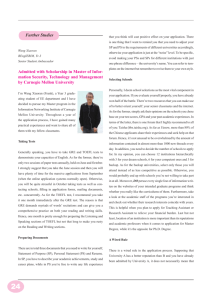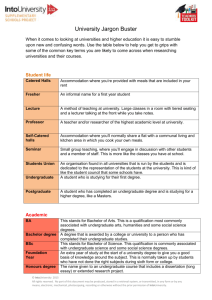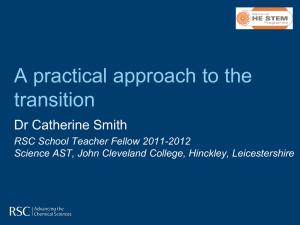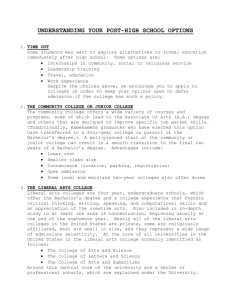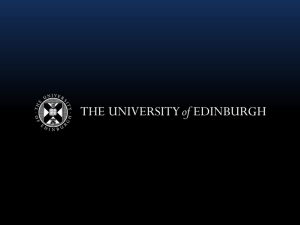education. - eng.fon.rs
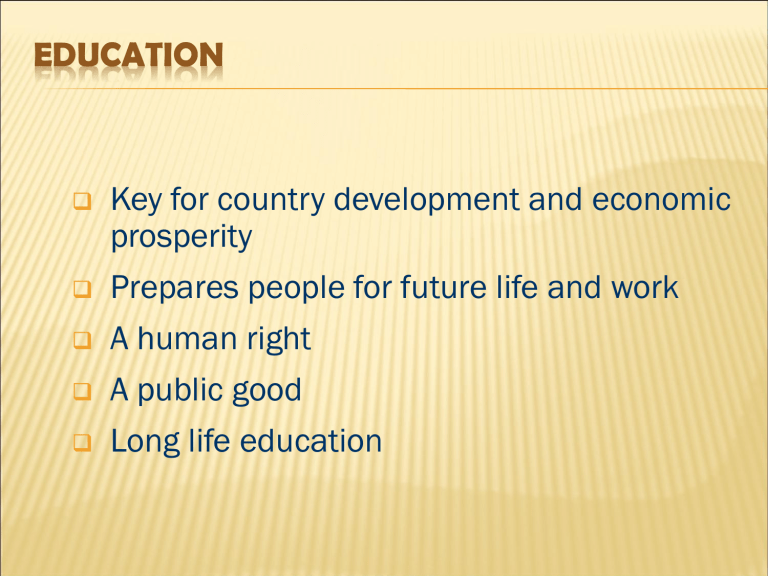
EDUCATION
Key for country development and economic prosperity
Prepares people for future life and work
A human right
A public good
Long life education
EDUCATION
Three levels:
Primary education (compulsory in almost all countries of the world).
Secondary education
Either enroll into university or seek employment.
Higher education
EDUCATION IN THE UNITED STATES
MAIN CHARACTERISTICS
Education provided in public schools, state-certified private schools, or an approved home school program.
CORE OF EDUCATION
The “ inquiry ” method of learning - schools are asked not only to teach the new information, but to help students ask their own questions about it.
THE GOAL OF AMERICAN EDUCATION
The goal of American education:
① To achieve universal literacy;
② To provide individuals with the knowledge and skills necessary to promote individual and general welfare
.
EDUCATIONAL SYSTEMS
1) There are 50 educational systems in the
United States.
Each state enjoys freedom to develop a school system as extensive or as limited as it desires.
EDUCATIONAL SYSTEMS
2) Local communities are given substantial freedom to select teachers and administrators and to schedule the school year and to meet the standards by the states.
EDUCATIONAL SYSTEMS
3) All educational matters are left to the individual state - educational policy is generally the responsibility of boards of education and there is no one uniform pattern of state administration.
YEARS OF EDUCATION
4) All states require young people to attend school to age 16 or 18.
Every children is guaranteed up to 13 years of education.
GENERAL SITUATION
Public schools 90%
Private schools 10% (4 out of 5 private schools are run by churches, synagogues or other religious groups)
Religious teachings are a part of the curriculum .
FUNDS (schools)
Funds for schools come from 3 sources:
Through local property taxes (approximately
50% is raised).
From the states’ budgets (approximately 40% -
50%).
Only 8% - 9% from the federal government.
FUNDS (college and universities)
They depend on mainly 3 sources:
student tuition
endowments (funds or property donated to institutions or individuals) government funding
LEVELS OF EDUCATION
Education is carried out at various levels, which are mainly divided into:
Elementary school - 1 st to 5 th grade
Middle school (junior high school) – 6 th to 8 th grade
High school (or secondary education)
Post-secondary education - college or university
ELEMENTARY AND SECONDARY EDUCATION
Elementary and secondary education covers 12 years from age 6 through 18.
SECONDARY EDUCATION
Secondary education may take place in a variety of junior and senior high schools.
Vocational and technical high schools: provide for a variety of occupations and vocations.
Academic high schools emphasize their schooling in academic and intellectual disciplines.
HIGHER EDUCATION APPLICANTS
a) b) c) d) e)
Successful applicants are chosen on the basis of:
High school records
Recommendations
The impression at interviews
Scores on the SATS (a series of educational assessments)
Community work
HIGHER EDUCATION
Higher education includes:
Undergraduate study - Bachelor’s degree
Graduate study - Master’s degree
Postgraduate study - Doctor’s degree
UNDERGRADUATE STUDENTS
Undergraduate students are classified according to their year of study.
First year : Freshmen
Second Year: Sophomores
Third-year Students: Juniors
Fourth-year students: Seniors
UNDERGRADUATE STUDIES
At the undergraduate level, students usually select their “ major ” plus a specific number of
“ electives ” .
In order to receive a degree, an undergraduate student has to earn a certain numbers of “ credits ”
(earned by attending lectures and by completing assignments and examinations).
UNDERGRADUATE STUDIES
A bachelor’s degree known as a major– usually four years of study:
A Bachelor of Arts (B.A.),
A Bachelor of Science (B.S.),
A Bachelor of Fine Arts (B.F.A.),
A Bachelor of Social Work (B.S.W.),
A Bachelor of Engineering (B.Eng.),
A Bachelor of Philosophy (B.Phil.)
COLLEGE vs. UNIVERSITY
College: usually refers to an institution that concentrates on a four-year study leading to graduation with a bachelor ’ s degree;
It sometimes refers to academic units within universities.
UNIVERSITY
University is usually larger and provides advanced research and studies in academic areas and professional fields leading to master and doctoral degree after four years of undergraduate work.
University can refer to a public system of higher education within a state that includes many campuses.
GRADUATE DEGREE
Graduate study leads to a master’s degree:
Master of Arts (M.A.),
Master of Science (M.S.),
Master of Business Administration (M.B.A.),
or other less common master's degrees:
Master of Education (Med.),
Master of Fine Arts (M.F.A.))
POST GRADUATE DEGREE
Graduate study leads to a doctor’s degree:
Doctor of Arts (D.A.),
Doctor of Science (D.S.),
Doctor of Business Administration (D.B.A.),
THE UNITED KINGDOM
MAIN CHARACTERISTICS
Education in the United Kingdom has separate systems under separate governments.
Each country of the UK has its own department for education
Scotland www.scotland.gov.uk/topics/education
Wales www.wales.gov.uk/topics/educationandskills
Northern
Ireland www.deni.gov.uk
GOALS
Goals
:
Bring together education, health and social services
Inclusion
Children with disabilities and challenging behaviour to be educated in mainstream (‘ordinary’) schools
Personalisation
Tailoring education to individual pupil need, aptitude and interest
Community cohesion
Local, national and international
Healthy eating
Fighting the trend towards obesity in young people
KEY PLAYERS
Department for
Education
Schools and
Governing
Bodies
Local
Authorities
DIFFERENT TYPES OF SCHOOL
Community Schools
Academies
Free Schools
Private schools
See: www.dfe.gov.uk
funded through the Local
Authorities funded directly by the government proposed by the government to be set up in response to parental request funded by private individuals organisations, or educational trusts
FREEDOM AND CONTROL
A head teacher and senior leaders have freedom to determine the ethos and practice of their schools … but also
full responsibility for the quality of education experienced by the young people in their care.
FREEDOM AND CONTROL
Schools are responsible for: learning and teaching appointment and management of all their staff the buildings and site including playing fields
A head teacher is accountable to a Governing Body that represents parents, the community and often the Local
Authority
There are national standards for head teachers
New head teachers must be accredited by the National
Professional Qualification for Headship
LEVELS OF EDUCATION
Establishments
Pre-School Nurseries
Primary Schools
Secondary Schools
Sixth Form Colleges
Further Higher Education
Special Schools
Age Range
Under 5
5-11
11-16 or 11-18 (19)
16-18 (19)
Over 16
3-18
PRE SCHOOL EDUCATION
For children from birth to five years there are six areas of learning which all providers must address:
Communication, language & Literacy
Knowledge & Understanding of the World
Physical Development
Creative Development
Personal, Social & Emotional Development
Problem Solving, Reasoning & Numeracy
PRIMARY SCHOOL
A child begins primary education during the school year he or she turns 5.
Education is compulsory for all children between the ages of 5 (4 in Northern Ireland) and 16 and 17; before this children can be educated at nursery.
SECONDARY EDUCATION
Students at both state schools and independent schools typically take GCSE
(General Certificate of Secondary Education) examinations (the end of compulsory education)
Students may then continue their secondary studies for a further two years (sixth form), leading most typically to A-level qualifications.
OPPORTUNITIES
At the age of 16 school children are free to leave school.
An increasing number of school leavers do training courses or particular jobs and careers.
Some go straight out and look a job (1/3 of such school leavers)
Those who find no immediate employment, take part in training schemes which involve on-thejob training combined with part-time college courses
OPPORTUNITIES
At the age of 16 many school leavers decide to stay in full-time –education.
School leavers stay in their schools to attend a Sixth-
Form-College or College of further Education Sixth form
In the education systems of England, Wales and
Northern Ireland a sixth form represents the final two years of secondary education, where students prepare for their A-level (or equivalent) examinations.
OTHER
Other qualifications and courses exist:
Business and Technology Education Council
(BTEC) qualifications,
The International Baccalaureate (IB)
The Cambridge Pre-U.
UNDERGRADUATE DEGREE
Students enter University from age 18 onwards, and study for an academic degree.
Higher education often begins with a three-year bachelor degree.
Students who have completed a first degree are eligible to undertake a postgraduate degree.
UNDERGRADUATE STUDENTS
Approx 400,000 undergraduate students enter UK universities annually
They enrol on to the more than 50,000 different courses on offer
UK has one of the highest completion rates for higher education courses in the OECD countries – http://www.timeshighereducation.co.uk/story.asp?story
Code=151645§ioncode=26
THE MOST POPULAR PROGRAMMES
Business and administrative studies
Engineering and technology
Social, economic and political studies
Computer science
Creative arts and design
Medicine and biological sciences
Languages www.thecompleteuniversityguide.co.uk
TESTING AND EXAMS
Establishments Key Stage(s) Main
Assessments
Primary Schools
Secondary Schools
Sixth Form Colleges
3
4
Foundation Stage
1
2
5
National Tests (11)
GCSE (16)
AS
A2
GCSE – General Certificate of Secondary Education
AS – first year of Advanced Level course
A2 – second/final year of Advanced Level
EXAMS
At the age of 16 school children pass:
GCSE exams - General Certificate of Secondary
Education (England, Wales and Northern Ireland) – t he system of marks is from A to G
Scottish Certificate of Education (SCE) ( Scotland) the system of marks is in numbers (number 1 is the best)
EXAMS
A levels are exams passed after completing a
Sixth Form College or a Sixth Form at the age of 18 (England, Wales and Northern Ireland)
SCE “Highers” are the Scottish equivalent of Alevels
Typically a student will pass three A-levels
EXAMS
GNVQ (General National Vocational
Qualification) are courses and exams in jobrelated subjects which are studied at the
Colleges of Further Education and are divided into five levels
COMPARATIVE TABLE OF LEVELS OF ENGLISH AND STANDARDISED EXAMS
Levels of knowledge
Common
European
Framework and ALTE levels
C2
Good User
C1
Competent User
B2
Independent User
B1
Threshold User
A2
Waystage User
A1
Breakthrough
General Englsih
Cambridge ESOL
General English Certificates
CPE
Certificate of Proficiency in English
(9501050 sati učenja)
CAE
Certificate in Advanced English
(750800 sati učenja)
FCE
First Certificate in English
(500600 sati učenja)
PET
Preliminary English Test
(250 -
300 sati učenja)
KET
Key English Test
(180 200 sati učenja)
Business English
English for
Lawyers
Financial Englsih General Englsih
Cambridge ESOL
Business English Certificates
ILEC
International
Legal English
Certificate
ICFE
International
Certificate in
Financial English
IELTS
International English
Language Testing System
BEC
Higher
BEC
Vantage
BEC
Preliminary
ILEC C1
ILEC B2
ICFE C1
ICFE B2
7.5 +
6.5
– 7.0
5.0
– 6.0
3.5 – 4.5
3.0
1.0 – 2.5
General Englsih
YLE
Cambridge
Young Learners
English Tests
Flyers
Starters
Movers
PRE-SESSIONAL ENGLISH FOR ACADEMIC PURPOSES (PEAP)
My current level is :
IELTS 4.5
TOEFL 457
CBTOEFL 137 iBT TOEFL 47
IELTS 5.0
TOEFL 480
CBTOEFL 157 iBT TOEFL 55
IELTS 5.5
TOEFL 510
CBTOEFL 180 iBT TOEFL 64
IELTS 6.0
TOEFL 540
CBTOEFL 207 iBT
TOEFL 76
IELTS 6.0
TOEFL 540
CBTOEFL 207 iBT TOEFL 76
PEAP 15 weeks
PEAP 10 weeks
PEAP 05 weeks
I need :
IELTS 6.5
TOEFL 560
CBTOEFL 220 iBT TOEFL 83
PEAP 20 weeks
PEAP 15 weeks
PEAP 10 weeks
PEAP 05 weeks
THE CURRICULUM
CORE SUBJECTS
English
Mathematics
Science
THE CURRICULUM
Art
Geography
History
Music
Design and Technology
Information and
Communications
Technology
Sex and Relationship
Education
Careers Education
Citizenship
Physical Education
Religious Education
CURRICULUM
Students aged 14-16
Compulsory subjects, e.g.
Mathematics
Entitlement subjects, e.g.
Modern Foreign Language
‘Options’ – examples:
Business Studies
Media Studies
Dance
Drama
CRITERIA
- Universities select students on the basis of Alevel results and interviews
- The course of studies in England, Wales and
Northern Ireland is three years , but for modern languages and certain vocational studies are four years
- In Scotland four years is the norm for most subjects
DEGREES
Bachelor Degree:
a Bachelor of Arts
a Bachelor of Science
Master Degree
a Master of Arts
a Master of Sciences
Doctorate
a Doctor of Philosophy
POSTGRADUATE DEGREE
Master’s degree (taught or by research, typically taken in one year, though researchbased master's degrees may last for two)
Doctorate (typically taken in three years)
Universities require a Royal Charter (a formal document issued by a monarch, granting a right or power to an individual - are financed by the state via tuition fees, which cost up to
£9,000 a term for English, Welsh and EU students.
HIGHER DEGREE (POSTGRADUATE) DOCTORATE PROGRAMMES
Research-based Doctorate (PhD/DPhil)
Awarded after a minimum of three years of supervised research
But it is important to recognise that only a minority are completed within this period – and all applicants must be sure of their funding to cover the often uncertain period required to complete what is, by definition, innovative research – see the report below.
http://www.hefce.ac.uk/pubs/hefce/2005/05_02/05_02.pdf
)
A useful example of PhD regulations can be found at http://www.campus.manchester.ac.uk/medialibr ary/researchoffice/graduateeducation/regphd.pdf
‘COST OF LIVING’ FOR NON-EU STUDENTS
Accommodation and Subsistence
University accommodation is usually about
£60.00 – £100.00 per week for term time, depending on facilities – but usually including electricity/heating
Independent accommodation – usually students sharing rented houses
(often ‘accredited’ by the university) – can work out similar, depending on type of accommodation. But watch possible add-ons like heating.
Subsistence is based on how much food is bought, along with ‘general personal maintenance’ – hairdressers, getting shoes repaired, or whatever.
As an example, Nottingham Trent University advises that students will require, in total, approximately £600 per month to cover living costs in
Nottingham.
UK UNIVERSITIES
More than 130 universities in United Kingdom:
‘Ancient’ universities – Oxford and Cambridge
19 th century universities i.e. Birmingham Manchester
Post 1945 i.e. Nottingham
Post 1962 i.e. Warwick, Kent
Post 1992 (re-designation of Polytechnics) i.e. Nottingham
Trent, Leeds Metropolitan
Post 2005 i.e. Chester, Winchester
UK UNIVERSITIES
All of universities in the United Kingdom are independent and self-governing , (and thus ‘non-state’) legal entities.
Nonetheless, a substantial amount of their funding comes from the state – mainly in support of the undergraduate programmes and capital investment
However, universities are accelerating the percentage of their revenue from own income generation – through post-graduate and professional courses, research income, international students and the controversial ‘top-up’ fees for ‘home’ students
(currently with the exception of Scottish ‘home’ students.)
UK UNIVERSITIES CONT.
Each university is empowered (by Royal Charter or Act of
Parliament) to develop its own courses and to award its own degrees.
Each university decides
the degrees it offers
the conditions on which they are awarded
what students to admit
what staff to appoint
AN EXCEPTION
The University of Buckingham (founded in 1976) is the only
Private University in UK
It is independent of government money and relies on student fees and private research grants and endowments
It has two-year undergraduate programmes
It has a large proportion of international students (70%)
OXBRIDGE (OXFORD AND CAMBRIDGE)
They are federations of semi-independent colleges
Each college has its own staff known as “Fellows”
The “Fellows” teach the students either one-toone or in small groups (tutorials and supervisions) lecturers and lab works are organized at university level before 1970 all Oxbridge colleges were single-sex nowadays the majority admit both sexes
TYPES OF UNIVERSITIES
The Old Scottish Universities
-
-
-
-
They are Glasgow, Edinburgh, Aberdeen and St
Andrews
St Andrews resembles Oxbridge
Glasgow, Edinburgh, Aberdeen resemble civic universities
In all of them the pattern of education is closer to the continental than to the English one
TYPES OF UNIVERSITIES
The early 19 th -century English universities
The University of London is the representative of this group
Each college is almost a separate university
Colleges are non-residential
TYPES OF UNIVERSITIES
The Older Civic (Redbrick) Universities
Used to be various institutions with a technical bias
Appeared in main industrial cities (Leeds,
Birmingham, Manchester)
Were built of local material, often brick in contrast to the stone ones
Prepared students for London University Degree
Were given the right to award their own degrees and became universities
TYPES OF UNIVERSITIES
The Newer Civic Universities (Aston, University of
Salford Manchester)
They were originally technical colleges
In 1970es became polytechnics (were allowed to teach degree courses)
In 1990es most of them became universities
Their notable feature is a “sandwich course”
TYPES OF UNIVERSITIES
The Campus University
Purpose-built institutions located in the countryside but close to towns
East Anglia, Lancaster, Sussex
New academic disciplines are introduced such as social studies
Teaching in small groups known as “seminars”
The Republic of Serbia
LEVELS OF EDUCATION
•
Pre-school/kindergarten (compulsory)
•
Primary education (compulsory)
•
Secondary education
•
Higher education
PRIMARY EDUCATION
•
•
Primary education between age 6/7 to 14/15) - two education cycles: the first from first to fourth grade (organized through the classroom teaching) and the second cycle of fifth to eighth grade (through subject teaching).
SECONDARY EDUCATION
Secondary education – 4 years:
Grammar,
Vocational
Art schools
HIGHER EDUCATION
•
•
•
University,
Faculty art academy,
College of professional studies.
DEGREES OF STUDIES
First degree : o undergraduate academics studies o
undergraduate professional studies
Second degree: o graduate academic studies - Master o o specialist professional studies specialist academic studies.
Doctoral academic studies - third degree.
ORGANIZATION OF STUDIES
Bachelor - the person that completes the undergraduate academic/ professional studies obtains the professional title of first degree of academic/professional studies in the appropriate field - Bachelor’s degree.
Master - graduate academic studies can be organized by a university, faculty and college, and last one or two years (depending on the duration of undergraduate academic studies).
After completing this studies the person gains the academic title - Master.
DOCTORAL STUDIES
Doctoral studies can be organized by universities or faculties and last at least one year, provided undergraduate and graduate academic studies that last at least five years.
The Law on Higher Education
The academic study programs in medical sciences with the total volume of maximum 360 ECTS.
The doctoral studies have at least 180 ECTS
The specialized professional studies 60 ECTS
The basic professional studies have 180 ECTS credits
The diploma academic studies
60 -120ECTS M.Sc.
Undergraduate
The academic studies
180 -240 ECTS B.Sc.
GRADING SYSTEM
Main grading system used by higher education institutions:
5-10 grading scale is used, with 6 as a pass level.
Highest on scale is 10, pass / fail level is 6 and
5 and the lowest on scale is 5.
Republic of Serbia
NATIONAL COUNCIL OF HIGHER EDUCATION
The National Council of Higher Education determined scientific, artistic and vocational areas within fields referred to in Article 27 of the Law on Higher Education based on the proposal of the
University Conference of Serbia (UCS) and the Conference of high school principals.
1. Field of life-mathematics sciences
2. Field of technical/technological sciences
3. Field of behavioral-humanistic sciences
4. Field of medical sciences
5. Field of arts
1. FIELD OF LIFE-MATHEMATICS SCIENCES
1.1. Biological sciences
1.2. Geo-sciences
1.3. Mathematic sciences
1.4. Environmental sciences and ergonomics
1.5. Computer sciences
1.6. Physical sciences
1.7. Physical and chemical sciences
1.8. Chemical sciences
2. FIELD OF TECHNICAL/TECHNOLOGICAL SCIENCES
2.1. Architecture
2.2. Biotechnical sciences
2.3. Civil engineering
2.4. Geodetic engineering
2.5. Electrical and computer engineering
2.6. Industrial engineering and engineering management
2.7. Environment protection engineering
2.8. Mechanical engineering
2.9. Organizational sciences
2.10. Mine engineering
2.11. Traffic engineering
2.12. Technological engineering
2.13. Metallurgical engineering
3. FIELD OF BEHAVIORAL-HUMANISTIC SCIENCES
3.1. Librarianship, archiving and museology
3.2. Economic sciences
3.3. Historical and archeological sciences
3.4. Cultural sciences and communicology
3.5. Management and business
3.6. Pedagogical sciences
3.7. Political sciences
3.8. Legal sciences
3.9. Psychological sciences
3.10. Sociological sciences
3.11. Theology
3.12. Philosophy
3.13. Philological sciences
3.14. Sciences of arts
4. FIELD OF MEDICAL SCIENCES
4.1. Veterinarian sciences
4.2. Medical sciences
4.3. Special education and rehabilitation
4.4. Dental sciences
4.5. Pharmaceutical sciences
4.6. Physical education and sports
5. FIELD OF ARTS
5.1. Drama and audio visual arts
5.2. Visual arts
5.3. Music and performance arts
5.4. Applied arts and music
THE BASIC PROFESSIONAL STUDIES
The qualifications which mark the completion of the basic professional studies shall be acquired by the student who:
demonstrated their knowledge in their study area, based on the previous education and able to use professional literature; capable of applying knowledge and understanding the profession; capable of transmitting knowledge to others; capable of continuing studies; capable for team work.
THE BASIC ACADEMIC STUDIES
The qualifications which mark the completion of the basic academic studies shall be acquired by the students who: demonstrated knowledge in the study area based on the previous education and which enables them to use professional literature, but also covered some aspects relying on key knowledge of their study area; capable of applying knowledge and understanding in the manner which reveals professional approach to the job or knowledge and have the abilities most frequently expressed in thoughtful arguments and solving problems within the study areas; capable of collecting and interpreting necessary data; capable of thinking of relevant social, scientific and ethical issues; develop abilities for continuation of studies.
DOCTORAL STUDIES
The qualifications which mark the completion of doctoral studies shall be acquired by the students who:
demonstrated system understanding of certain studies; who mastered the skills and methods of research in their field;
demonstrated the ability to conceive, design and apply; who demonstrated the ability of adaptation of the research process with the necessary degree of academic integrity;
by their own original research and work achieved the creation which pushed the frontiers of knowledge published and which is of national and international reference;
capable of critical analysis, appraisal and synthesis of new and complex ideas;
capable of transmitting professional knowledge and ideas to their colleagues, wider academic community and society at large;
capable of imparting, in the academic and professional setting, the technological, social or cultural progress.

